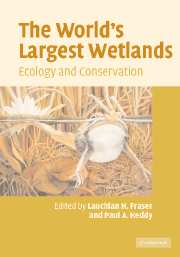Book contents
- Frontmatter
- Contents
- List of contributors
- Preface
- 1 Introduction: big is beautiful
- 2 The West Siberian Lowland
- 3 The Amazon River basin
- 4 The Hudson Bay Lowland
- 5 The Congo River basin
- 6 The Mackenzie River basin
- 7 The Pantanal
- 8 The Mississippi River alluvial plain
- 9 The Lake Chad basin
- 10 The River Nile basin
- 11 The prairie potholes of North America
- 12 The Magellanic moorland
- 13 The future of large wetlands: a global perspective
- Index
Preface
Published online by Cambridge University Press: 10 August 2009
- Frontmatter
- Contents
- List of contributors
- Preface
- 1 Introduction: big is beautiful
- 2 The West Siberian Lowland
- 3 The Amazon River basin
- 4 The Hudson Bay Lowland
- 5 The Congo River basin
- 6 The Mackenzie River basin
- 7 The Pantanal
- 8 The Mississippi River alluvial plain
- 9 The Lake Chad basin
- 10 The River Nile basin
- 11 The prairie potholes of North America
- 12 The Magellanic moorland
- 13 The future of large wetlands: a global perspective
- Index
Summary
From the vast deltas of the Amazon and Volga, to the bogs of the arctic tundra, and the mosaic prairie potholes of North America, wetlands come in all shapes and sizes. Wetlands are the fragile interface between land and water. Human civilization has been inextricably linked to wetlands because of their economic and aesthetic value. Only recently has it been shown that wetlands perform very important functions in our environment. They have been described as “the kidneys of the landscape” because of their effect on hydrological and chemical cycles, and because they receive downstream wastes from both natural and human sources. They have been found to cleanse polluted waters, prevent floods, protect shorelines, and recharge groundwater aquifers. Wetlands are also referred to as “biological supermarkets” because of the numbers of species and the abundance of biomass they support. They play major roles in the landscape by providing habitat for a wide variety of flora and fauna. These generalizations apply whether one is describing the bottomland hardwoods of the Mississippi River valley, the Pantanal in South America, or the Sudd wetlands of the Upper Nile in Africa.
Approximately 50% of the world's wetlands have been lost. No country is isolated from the impacts of human overpopulation. Therefore we took a global perspective to ensure that the largest wetlands are understood and wisely managed. Little is known about some of the largest wetlands. The research that has been done is fragmented and published (if at all) in obscure journals.
- Type
- Chapter
- Information
- The World's Largest WetlandsEcology and Conservation, pp. ix - xPublisher: Cambridge University PressPrint publication year: 2005



